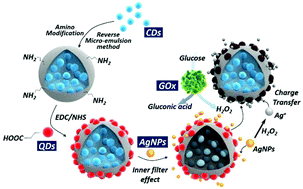A novel dual response ratiometric fluorescent probe for the determination of H2O2 and glucose via etching of silver nanoparticles†
Abstract
Based on the inner filter effect and charge transfer dual response mechanism, a dual response ratiometric fluorescent probe (D-RFP) with two reversible signal changes for sensing H2O2 and glucose was developed. The D-RFP was proposed by embedding glycine-derived carbon dots (CDs) (λem = 400 nm) into silica nanoparticles and covalently linking CdTe quantum dots (QDs) (λem = 600 nm) onto the surface of silica nanoparticles. When silver nanoparticles (Ag NPs) were mixed with D-RFP, the fluorescence intensity of CDs can be quenched by Ag NPs via the inner filter effect. With the addition of H2O2, Ag NPs were etched to silver ions, thus recovering the fluorescence of CDs. In the meantime, fluorescence of QDs was quenched by Ag+via charge transfer. Under optimal conditions, D-RFP displayed high sensitivity toward H2O2 with a detection limit of 0.28 μM. Based on the conversion of glucose into H2O2, D-RFP can also be exploited for glucose sensing with a detection limit of 0.59 μM. The approach developed can be applied to monitor glucose levels in human serum samples with satisfactory results, and the results of the heathy and diabetic patients can be distinguished by the naked eye. Moreover, this method provides a new idea for designing a high-sensitivity D-RFP.



 Please wait while we load your content...
Please wait while we load your content...